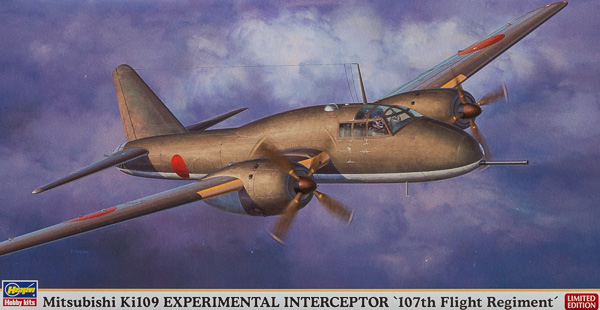
Hasegawa 1/72 Mitsubishi Ki-109 Experimental Interceptor "107th Flight Regiment"
By Chris Banyai-Riepl
Overview
The Mitsubishi Ki-67 was developed as a successor to the Nakajima Ki-49 for the high-speed twin-engined heavy bomber role. Unlike many Japanese aircraft of the time, it was expected to have excellent defensive weaponry as well as being very durable. High maneuverability was also key, as the type needed to be able to dive bomb and escape at low altitude. Fitting the medium bomber category, the Ki-67 had a comparable bomb load to the B-25, B-26, and A-20, but had significantly better performance in all categories.
This maneuverability resulted in the Ki-109 experimental interceptor that was originally created to be a night fighter. The first prototypes were designed to operate in pairs, with the Ki-109a incorporating a radar/reflector and the Ki-109b having two 37mm cannons mounted obliquely. This was just a project, though, and the production Ki-109 was a heavy fighter interceptor, with a fixed 75mm cannon in the nose and a 12.7mm gun in the tail for defensive purposes. Twenty-two of these were produced before the war ended.
The Kit
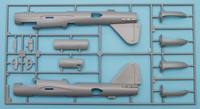 The Hasegawa Ki-109 kit is a derivative of their Ki-67 kit, much like the original was. The Ki-67 kit was originally released in the late 1990s, while the Ki-109 variant came about much later. This is the second release of the Ki-109, and it features the stock Ki-67 plastic along with some resin and metal accessories to convert it into the Ki-109. As a newer Hasegawa kit, this one features recessed panel lines, good interior detailing, and a decal sheet with two options.
The Hasegawa Ki-109 kit is a derivative of their Ki-67 kit, much like the original was. The Ki-67 kit was originally released in the late 1990s, while the Ki-109 variant came about much later. This is the second release of the Ki-109, and it features the stock Ki-67 plastic along with some resin and metal accessories to convert it into the Ki-109. As a newer Hasegawa kit, this one features recessed panel lines, good interior detailing, and a decal sheet with two options.
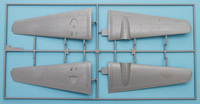 As this is the fighter version based on the bomber version, there is a lot of interior detailing that won't be visible for the production Ki-109. As the kit provides markings for a prototype option, though, some of this interior will be seen. You get a one piece floor, which features lots of added detailing for both the belly bomb bay and the main cockpit area. The cockpit area gets separate seats, separate radio equipment, a control wheel, and an instrument panel. There is also a fuel tank piece, and additional details for the mid-fuselage turret and side gun positions. The instructions also indicate removing the forward edge of the fuselage, in preparation for the resin nose piece.
As this is the fighter version based on the bomber version, there is a lot of interior detailing that won't be visible for the production Ki-109. As the kit provides markings for a prototype option, though, some of this interior will be seen. You get a one piece floor, which features lots of added detailing for both the belly bomb bay and the main cockpit area. The cockpit area gets separate seats, separate radio equipment, a control wheel, and an instrument panel. There is also a fuel tank piece, and additional details for the mid-fuselage turret and side gun positions. The instructions also indicate removing the forward edge of the fuselage, in preparation for the resin nose piece.
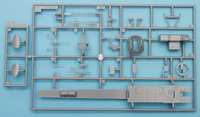 The resin parts consist of a replacement nose and the fairing for the rear fuselage. Both the prototype and production Ki-109s use the nose, while only the production variant needs the rear fuselage fairing. The production Ki-109 also has plugs for the side armament blisters, which results in a much smoother, more streamlined aircraft. As this is the fighter version, there's no need to have the bomb bay open, so the one-piece bomb bay door can be glued in place closed.
The resin parts consist of a replacement nose and the fairing for the rear fuselage. Both the prototype and production Ki-109s use the nose, while only the production variant needs the rear fuselage fairing. The production Ki-109 also has plugs for the side armament blisters, which results in a much smoother, more streamlined aircraft. As this is the fighter version, there's no need to have the bomb bay open, so the one-piece bomb bay door can be glued in place closed.
 Moving on to the wings, these are split into upper and lower halves, with the engine nacelles separate. The wings have large tabs that will help provide a sturdy joint. For the engine nacelles, these are made up from quite a few parts. The nacelle body is split into right and left halves, while the cowling is molded as one piece, with a separate insert for the engine face. The exhausts are separate, and there is a separate piece to hold the plastic ferrule for the propeller. The propeller features a two-part hub, blades molded in one piece, and a separate impeller piece. With the close-fitting cowling and impeller, not much else can be seen on the engine.
Moving on to the wings, these are split into upper and lower halves, with the engine nacelles separate. The wings have large tabs that will help provide a sturdy joint. For the engine nacelles, these are made up from quite a few parts. The nacelle body is split into right and left halves, while the cowling is molded as one piece, with a separate insert for the engine face. The exhausts are separate, and there is a separate piece to hold the plastic ferrule for the propeller. The propeller features a two-part hub, blades molded in one piece, and a separate impeller piece. With the close-fitting cowling and impeller, not much else can be seen on the engine.
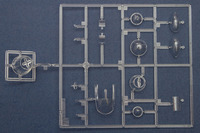 With the wings together and in place, and the stabilizers glued in place, the only thing left is the final details. The landing gear is suitably detailed, with the struts featuring separate retraction arms. The wheels are split into right and left halves, and feature a flat spot, simulating the weight of the aircraft on the tires. The tailwheel is molded as a single part. For clear parts, the canopy features the option of open or closed top hatches, while the rear-mounted 12.7mm gun fits into a large clear piece with a separate end cap.
With the wings together and in place, and the stabilizers glued in place, the only thing left is the final details. The landing gear is suitably detailed, with the struts featuring separate retraction arms. The wheels are split into right and left halves, and feature a flat spot, simulating the weight of the aircraft on the tires. The tailwheel is molded as a single part. For clear parts, the canopy features the option of open or closed top hatches, while the rear-mounted 12.7mm gun fits into a large clear piece with a separate end cap.
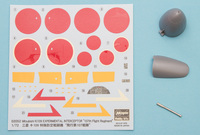 For the painting schemes, you are limited to fairly boring markings, as there were too few of these planes built and too late in the war to garner much in the way of fancy tail markings. If you want interesting, you'll want to look at the prototype option. While both choices are from the 107th Flight Regiment, the prototype option has a complicated camouflage of dark green squiggles over the base green gray. While more interesting, this scheme will be quite the challenge to apply. For the production option, you get a much simpler scheme, consisting of dark brown light gray green. In both cases, the only markings worn by the aircraft are hinomarus.
For the painting schemes, you are limited to fairly boring markings, as there were too few of these planes built and too late in the war to garner much in the way of fancy tail markings. If you want interesting, you'll want to look at the prototype option. While both choices are from the 107th Flight Regiment, the prototype option has a complicated camouflage of dark green squiggles over the base green gray. While more interesting, this scheme will be quite the challenge to apply. For the production option, you get a much simpler scheme, consisting of dark brown light gray green. In both cases, the only markings worn by the aircraft are hinomarus.
Conclusion
While not as common in the modeling world as other participants' aircraft, the planes of the Japanese military offer some interesting designs, and it is great to see Hasegawa tackle so many of them. This release of the Ki-109 is no exception, and the great plastic parts coupled with the quality resin conversion parts make this a great addition to any Japanese collection. My thanks to Hasegawa USA for the review sample.
